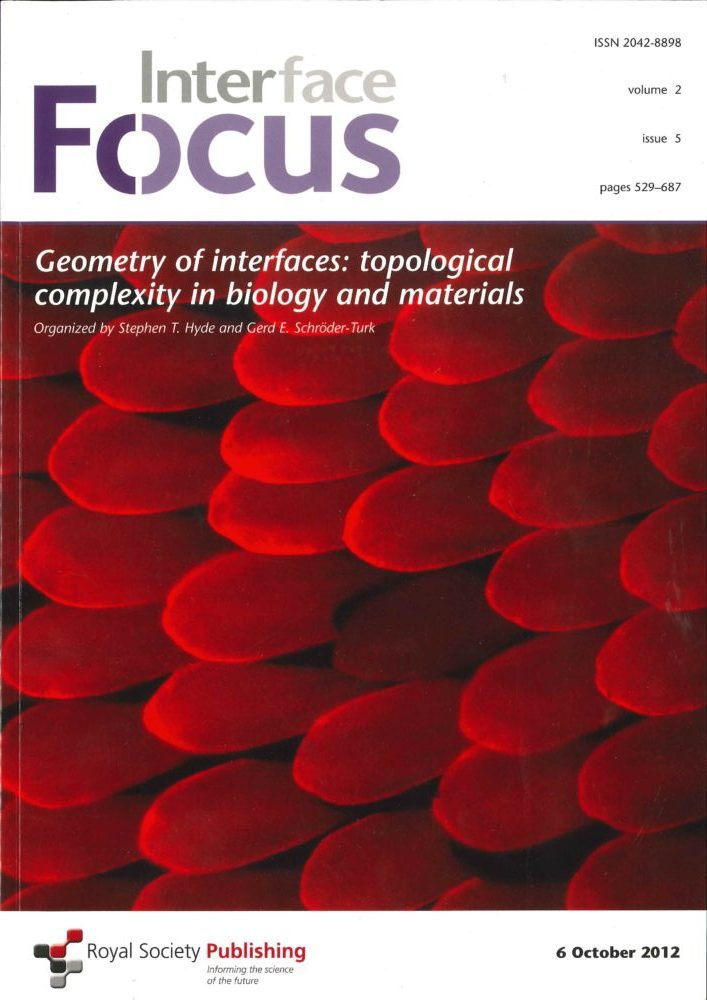Structure formation in soft matter and biological materials
Few would not have heard of D’Arcy Thompson’s famous book “On Growth and Form“, now over a century old, which considered structure formation in nature largely rationalised by the effect of physical forces and geometry. My research into structure formation is based on the belief that, in line with Thompson’s core argument, physical forces and geometry, and statistical physics, provide the profound and fundamental understanding of how structure forms.
Today’s scientific world of course has seen incredible progress in molecular biology and has impressive abilities to study molecularly complex spatial structure formation by simulations in silico. Yet, often the resulting complex structures, and sometimes the dynamic mechanisms of their formation, can be well  rationalised in terms of simple geometric arguments, often related to packing and spatial distribution. This paradigm underlies quite a few of the articles in two Interface Focus volumes that I have co-edited
rationalised in terms of simple geometric arguments, often related to packing and spatial distribution. This paradigm underlies quite a few of the articles in two Interface Focus volumes that I have co-edited
- S.T. Hyde, G.E. Schröder-Turk, M.E. Evans and B.D. Wilts, “Emergence and function of complex form in self-assembly and biological cells“, Interface Focus 7(4), 20170035, not peer-reviewed (2017)
- S.T. Hyde and G.E. Schröder-Turk, “Geometry of Interfaces: topological complexity in biology and materials”, Editorial and Introduction for issue of Interface Focus 5, organized by S.T. Hyde and G.E. Schröder-Turk, Interface Focus 2(5), 529-538 (2012)
In a very different context of topological phase transitions, Nobel Laureate Duncan Haldane has emphasized the importance of the concept of toy models for the progress of science. A Toy model, one of theoretical physics’ favourite concepts, is the reduction of a complex problem to a simplest possible scenario that still captures the effect in question, hence laying out in clearest terms the essence of the mechanism behind a particular observation.
I consider that, often (but not always), for structure formation in both synthetic and biological systems the underlying toy model is one of geometry, be it through optimisation or fundamental constraints. (Stephen Hyde’s wonderful illustration, published in “Boxing Partula” Forma in 1997, of the warping of a slice of toast into a saddle shaped sheet remains a highlight of this principle! He has also written an interesting review of Thompson’s book, see here). Much of my work on structure formation is motivated by that quest for the essential geometric toy model that illuminates the essence of why a particular structure forms.
Bicontinuous phases and network-like topologies
The bulk of my work on structure formation in soft matter and biological materials concerns the formation of bicontinuous phases and related geometries. Please see the “Bicontinuous phases and ordered networklike nanostructures ” for a description of those research results.
Hidden order and hyperuniformity in cellular systems
- M.A. Klatt, J. Lovric, D. Chen, S.C. Kapfer, F.M. Schaller, P.W.A. Schönhöfer, B.S. Gardiner, A.-S. Smith, G.E. Schröder-Turk, S. Torquato, “Universal hidden order in amorphous cellular geometries“, Nature Communications 10, 811 (2019)
“Only entropy comes easy” : Order in entropy-dominated systems
Anton Chekhov’s famous quote alludes to a well established principle of thermodynamics and statistical physics. What continues to be a surprise is that entropy is not always destructive, that it does not always lead to disorder. The work by Pusey & Van Megen (Nature 1986) of the crystallisation of colloidal spheres that results in specular reflections is a spectacular experimental demonstration of this principle, based on the order transition of hard spheres with no attractive potential into an ordered lattice (See also the Science 2015 review by Manoharan). Some of our recent work has addressed the question of meso-scale order formation of Gyroid phases by this very driver … entropy!
- P.A. Schönhöfer, D. Cleaver and G.E. Schröder-Turk, “Double diamond phase in pear-shaped nanoparticle systems with hard sphere solvent“, Journal of Physics D: Applied Physics 51(46), 464003 (2018)
- P.A. Schönhöfer, G.E. Schröder-Turk, M. Marechal, “Density functional theory for hard uniaxial particles: Complex ordering of pear-shaped and spheroidal particles near a substrate“, The Journal of Chemical Physics 148, 124104 (2018)
- Philipp W. A. Schönhöfer, Laurence J. Ellison, Matthieu Marechal, Douglas J. Cleaver, and Gerd E. Schröder-Turk, “Purely Entropic Self-Assembly of the Bicontinuous Ia3d Gyroid-Phase“, Interface Focus 7(3), 20160161 (2017)
- G.E. Schröder-Turk, “The Hard Core of Soft Matter: Kugelsysteme in der weichen Materie“, Mitteilungen der Deutschen Mathematiker Vereinigung (MDMV), not peer-reviewed, vol 23, issue 4, pages 208-217, (2015)
Non-linear pattern formation and Turing patterns
- C. Scholz, G.E. Schröder-Turk, and K. Mecke, “Pattern-fluid interpretation of chemical turbulence“, Phys. Rev. E 91, 042907 (2015)
- G.E. Schröder-Turk, S. Kapfer, B. Breidenbach, D. Hug, C. Beisbart and K. Mecke, “Tensorial Minkowski functionals and anisotropy measures for planar patterns”, Journal of Microscopy, 238 (1), 57-74 (2010)
Ordering transition in packing problems of granular spheres
- S.C. Kapfer, W. Mickel, K. Mecke, and G.E. Schröder-Turk, Jammed Spheres: Minkowski Tensors Reveal Onset of Local Crystallinity , Phys. Rev. E 85 , 030301(Rapid Communication) (2012)
